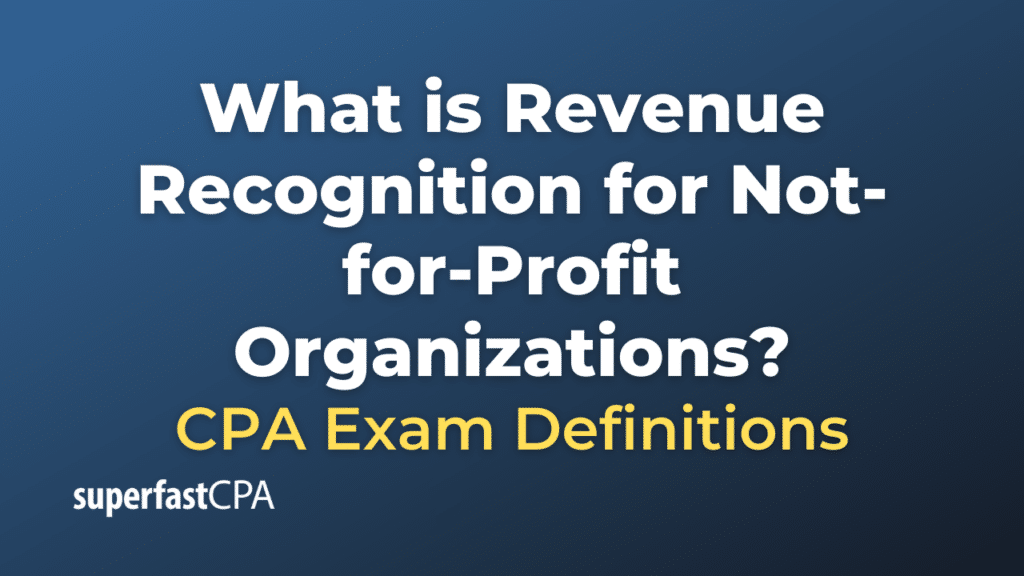Revenue Recognition for Not-for-Profit Organizations
Revenue recognition for not-for-profit organizations refers to the accounting principles and standards that dictate when and how revenue is recorded in the organization’s financial statements. Non-profit organizations can have diverse sources of revenue, including donations, membership dues, program fees, grants, and investment income, each of which may have different recognition requirements.
The Financial Accounting Standards Board (FASB) in the United States has certain standards for revenue recognition by not-for-profit entities.
Here are some key principles:
1. Contributions: These are voluntary non-reciprocal transfers, such as donations, gifts, and grants. Contributions are recognized as revenue when they are promised or received, depending on the organization’s accounting method (cash-based or accrual-based).
If a contribution is restricted by the donor (for example, it must be used for a specific purpose or not used until a future date), it is initially recognized as “with donor restrictions” revenue and reclassified as “without donor restrictions” revenue when the restrictions are met.
2. Exchange Transactions: These are reciprocal transactions where each party receives and sacrifices something of approximately equal value, such as program fees or sales of goods and services. Revenue from exchange transactions is recognized when or as the organization fulfills its obligations to the customer. This could involve providing goods, services, or access to resources.
3. Conditional Contributions: These are contributions that come with a barrier that must be overcome and a right of return for the donor if the barrier is not overcome. Revenue from conditional contributions is recognized only when the conditions are substantially met or explicitly waived by the donor.
The FASB updated these principles with Accounting Standards Update (ASU) No. 2018-08, which aimed to provide clearer guidelines on recognizing grants and similar contracts as either contributions or exchange transactions, and on distinguishing between conditional and unconditional contributions.
The revenue recognition rules for not-for-profit organizations can be complex due to the diversity of revenue sources and the often-present restrictions or conditions. It’s important for these organizations to have a clear understanding of these rules and apply them consistently to ensure accurate financial reporting.
Please note that the above information is based on U.S. Generally Accepted Accounting Principles (GAAP) and FASB standards, and the specific standards and practices may vary in other countries.
Example of Revenue Recognition for Not-for-Profit Organizations
Let’s consider a not-for-profit organization called “City Library Foundation,” which operates to support a public library.
- Unconditional Contributions: Let’s say in 2023, the City Library Foundation receives a cash donation of $10,000 with no restrictions or conditions. This contribution is considered revenue at the time it is received, so the foundation would record $10,000 in “Contributions – Without Donor Restrictions” revenue in its 2023 financial statements.
- Contributions With Donor Restrictions: Suppose a donor gives $50,000 to the foundation but specifies that the money must be used to purchase new books for the library. This gift is recognized in the financial statements as “Contributions – With Donor Restrictions” revenue. Then, when the foundation uses the money to purchase books (which is when the restriction is met), it would reclassify this amount as “Without Donor Restrictions” revenue.
- Conditional Contributions: Imagine a donor pledges $100,000 to the foundation on the condition that the foundation raises an additional $100,000 from other donors. In this case, the foundation would not recognize any revenue at the time of the pledge. Once the foundation raises the additional $100,000 (thus meeting the condition), it would then recognize the original $100,000 pledge as “Contributions – Without Donor Restrictions” revenue.
- Exchange Transactions: Suppose the foundation charges $500 per year for a membership that includes borrowing privileges and invitations to special events. When a patron pays the $500 membership fee, the foundation would recognize $500 in revenue from exchange transactions.
The timing and classification of this revenue recognition would depend on when and how the foundation provides the privileges and benefits to the member. If the membership is for a calendar year, and the patron pays the fee at the beginning of the year, the foundation might recognize the revenue evenly over the year (e.g., $41.67 per month).
These examples illustrate how revenue recognition for not-for-profit organizations depends on the nature of the revenue and any conditions or restrictions attached to it. The foundation would need to track each type of revenue separately and ensure that it meets any conditions or restrictions before recognizing the revenue.












